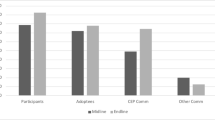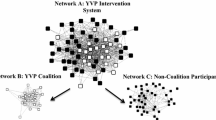Abstract
Collaboration is a ubiquitous approach to change, but is notoriously difficult and not definitively linked to desirable outcomes. Not surprisingly, the collaboration literature is replete with numerous facilitators and barriers to collaborative efforts. The current study aimed to develop a parsimonious model of factors influencing the success of collaborative efforts both internal and external to the council, including, (a) features of the council environment, (b) intermediate outcomes including the empowerment of members in the council context and the degree to which councils have generated social capital and (c) the extent to which collaborative efforts are occurring in a community context supportive of their aims. In particular, this study examines whether these factors affect the extent to which councils are positioned to achieve institutionalized change, or changes “in the text” that govern front line providers’ (e.g., police, advocates) practices in the community response to intimate partner violence. Results suggest that perceived member empowerment, generation of social capital, and supportive community context are the most important predictors of the extent to which councils foster shifts in institutionalized change. Features of the council environment are only indirectly related to the degree to which institutionalized change is ultimately fostered as mediated by the generation of social capital. This suggests that the ability of members to act as change agents and the extent to which those in power support council efforts figure more prominently to facilitate or constrain council efforts than council functioning itself.

Similar content being viewed by others
Notes
Council structure and breadth are level II predictors only.
Though leadership at level 1, and council climate at level II are significant, their effect is in the opposite direction as that expected (likely reflecting a restricted range).
We also explored the extent to which member empowerment functioned as a mediator of the relationship between council features and institutionalized change. Results did not provide support for member empowerment as a mediator.
References
Allen, N. E. (2005). A multilevel analysis of community coordinating councils. American Journal of Community Psychology, 35(1/2), 49–63.
Allen, N. E. (2006). An examination of the effectiveness of domestic violence coordinating councils. Violence Against Women, 12(1), 46–67.
Allen, N. E., Javdani, S., Anderson, C. J., Rana, S., Newman, D., Todd, N., et al. (2009). Coordinating the criminal justice response to intimate partner violence: The role of coordinating councils in systems change. A report prepared for the National Institute of Justice.
Allen, N. E., Watt, K., & Hess, J. Z. (2008). The outcomes and activities of domestic violence coordinating councils. American Journal of Community Psychology, 41(1/2), 63–73.
Berkowitz, B. (2001). Studying the outcomes of community-based coalitions. American Journal of Commuity Psychology, 29(2), 213–227.
Butterfoss, F. (1993). Coalitions for alcohol and other drug abuse: Factors predicting effectiveness. Unpublished doctoral dissertation, University of South Carolina, Columbia.
Butterfoss, F. D., Goodman, R. M., & Wandersman, A. (1996). Community coalitions for prevention and health promotion: Factors predicting satisfaction, participation, and planning. Health Education Quarterly, 23, 65–79.
Byrk, A. S., & Raudenbush, S. W. (1992). Hierarchical linear models. Newbury Park, CA: Sage Publications.
Campbell, C., Cornish, F., & Mclean, C. (2004). Social capital, participation and the perpetuation of health inequalities: Obstacles to African-Caribbean participation in ‘partnerships’ to improve mental health. Ethnicity & Health, 9, 313–335.
Chavis, D. M. (2001). The paradoxes and promise of community coalitions. American Journal of Commuity Psychology, 29(2), 309–320.
Clark, S. J., Burt, M. R., Schulte, M. M., & Maguire, K. (1996). Coordinated community responses to domestic violence in six communities: Beyond the justice system. Final Report to the U. S. Department of Health and Human Services by the Urban Institute, Washington, DC.
Cohen, J., & Cohen, P. (1983). Applied multiple regression/correlation analysis for the behavioral sciences (2nd ed.). Hillsdale, NJ: Erlbaum.
Crowley, K. M., Yu, P., & Kaftarian, S. J. (2000). Prevention actions and activities make a difference: A structural equation model of coalition building. Evaluation and Program Planning, 23, 381–388.
Fawcett, S. B., Paine-Andrews, A., Francisco, V. T., Schultz, J. A., Richter, K. P., Lewis, R. K., et al. (1995). Using empowerment theory in collaborative partnerships for community health development. American Journal of Community Psychology, 23, 677–697.
Flewelling, R. L., Austin, D., Hale, K., LaPlante, M., Liebig, M., Piasecki, L., et al. (2005). Implementing research-based substance abuse prevention in communities: Effects of a coalition-based prevention initiative in Vermont. Journal of Community Psychology, 33(3), 333–353.
Florin, P. (1996). 1996 Task force member survey. Community Research and Services Team: Center for Alcohol and Addiction Studies. Brown University, Rhode Island.
Florin, P., Mitchell, R., Stevenson, J., & Klein, I. (2000). Predicting intermediate outcomes for prevention coalitions: A developmental perspective. Evaluation and Program Planning, 23, 341–346.
Foster-Fishman, P. G., Berkowitz, S. L., Lounsbury, D. W., Jacobson, S., & Allen, N. E. (2001). Building collaborative capacity in community coalitions: A review and integrative framework. American Journal of Community Psychology, 29(2), 241–261.
Foster-Fishman, P., Salem, D., Allen, N. E., & Fahrbach, K. (1999). Ecological factors impacting provider attitudes towards human service delivery reform. American Journal of Community Psychology, 27(6), 785–816.
Gamache, D., & Asmus, M. (1999). Enhancing networking among service providers: Elements of successful coordination strategies. In M. F. Shepard & E. L. Pence (Eds.), Coordinating community responses to domestic violence: Lessons from Duluth and beyond (pp. 65–87). Thousand Oaks, CA: Sage Publications Inc.
Garland, B., Crane, M., Marino, C., Stone-Wiggins, B., Ward, A., & Friedell, G. (2004). Effect of community coalition structure and preparation on the subsequent implementation of cancer control activities. American Journal of Health Promotion, 18, 424–434.
Greenhalgh, T., Glenn, R., MacFarlane, F., Bate, P., & Kyriakidou, O. (2007). Diffusion of innovations in service organizations: Systematic review and recommendations. Milbank Quarterly, 82, 581–629.
Hausman, A. J., Becker, J., & Brawer, R. (2005). Identifying value indicators and social capital in community health partnerships. Journal of Community Psychology, 33, 691–703.
Hays, C. E., Hays, S. P., DeVille, J. O., & Mulhall, P. F. (2000). Capacity for effectiveness: The relationship between coalition structure and community impact. Evaluation and Program Planning, 23, 373–379.
Himmelman, A. T. (2001). On coalitions and the transformation of power relations: Collaborative betterment and collaborative empowerment. American Journal of Community Psychology, 29, 277–284.
Javdani, S., & Allen, N. E. (2011). Proximal outcomes matter: A multilevel examination of the processes by which coordinating councils produce change. American Journal of Community Psychology, 47(1/2), 12–27.
Javdani, S., & Allen, N. E. (2010). Councils as empowering contexts: Mobilizing the front line to foster systems change in the response to intimate partner violence. American Journal of Community Psychology. doi:10.1007/s10464-010-9382-1.
Kegler, M. C., Steckler, A., McLeroy, K., & Malek, S. H. (1998). Factors that contribute to effective community health promotion coalitions: A study of 10 Project ASSIST Coalitions in North Carolina. Health Education and Behavior, 25, 338–353.
Klein, K. J., & Sora, J. S. (1996). The challenge of innovation implementation. The Academy of Management Review, 21, 1055–1080.
Lasker, R. D., & Weiss, E. S. (2003). Broadening participation in community problem solving: A multidisciplinary model to support collaborative practice and research. Journal of Urban Health: Bulletin of the New York Academy of Medicine, 80, 14–60.
Lasker, R. D., Weiss, E. S., & Miller, R. (2001). Partnership synergy: A practical framework for studying and strengthening the collaborative advantage. The Milbank Quarterly, 79, 179–205.
Lehrner, A., & Allen, N. E. (2009). Still a movement after all these years? Current tensions in the domestic violence movement. Violence Against Women, 15, 656–677.
Mandarano, L. (2009). Social network analysis of social capital in collaborative planning. Society and Natural Resources, 22, 245–260.
McMillan, B., Florin, P., Stevenson, J., Kerman, B., & Mitchell, R. E. (1995). Empowerment praxis in community coalitions. American Journal of Community Psychology, 23, 699–727.
Metzger, M. E., Alexander, J. A., & Weiner, B. J. (2005). The effects of leadership and governance processes on member participation in community health coalitions. Health Education & Behavior, 32(4), 455–473.
Norris, T. (2001). America’s communities movement: Investing in the civic landscape. American Journal of Community Psychology, 29(2), 301–307.
Payne, C. A. (2001). The evolution of community involvement in public health community-based efforts: A case study. Journal of Health and Social Policy, 14, 55–70.
Pence, E. (1999). Some thoughts on philosophy. In M. F. Shepard & E. Pence (Eds.), Coordinating community responses to domestic violence: Lessons from Duluth and beyond (pp. 25–40). Thousand Oaks, CA: Sage.
Perkins, D. D., Florin, P., Rich, R. C., Wandersman, A., & Chavis, D. M. (1990). Participation and the social and physical environment of residential blocks: Crime and community context. American Journal of Community Psychology, 18(1), 83–115.
Peterson, N. A., & Reid, R. J. (2002). Paths to psychological empowerment in an urban community: Sense of community and citizen participation in substance abuse prevention activities. Journal of Community Psychology, 31, 25–38.
Reininger, B., Martin, D. W., Ross, M., Sinicrope, P. M., & Dinh-Zarr, T. (2001). Advancing the theory and measurement of collective empowerment: A qualitative study. International Quarterly of Community Health Education, 19, 293–320.
Snell-Johns, J., Imm, P., Wandersman, A., & Claypoole, J. (2003). Roles assumed by a community coalition when creating environmental and policy-level changes. Journal of Community Psychology, 31, 661–670.
Strong, D. A., Ciemnecki, A., Finkelstein, D., Hawkinson, L., & Richardson, A. (2006). Moving from intervention to prevention of intimate partner violence: A formative report on the DELTA Program. Princeton, NJ: Mathematica Policy Research, Inc.
Wagenaar, A. C., Erickson, D. J., Harwood, E. M., & O’Malley, P. M. (2006). Effects of State coalitions to reduce underage drinking. American Journal of Preventive Medicine, 31, 307–315.
Weiner, B. J., Alexander, J. A., & Shortell, S. M. (2002). Management and governance processes in community health coalitions: A procedural justice perspective. Health Education & Behavior, 29, 737–754.
Wolff, T. (2001). Community coalition-building—Contemporary practice and research: Introduction. American Journal of Community Psychology, 29, 165–171.
Yancey A. K., Kumanyika S. K., Ponce N. A., McCarthy W. J., Fielding J. E., Leslie J. P., et al. (2004). Population-based interventions engaging communities of color in healthy eating and active living: A review. Preventing Chronic Disease. Retrieved from http://www.cdc.gov/pcd/issues/2004/jan/03_0012.htm.
Yin, R. K., & Kaftarian, S. J. (1997). Introduction: Challenges of community-based program outcome evaluations. Evaluation and Program Planning, 20(3), 293–297.
Zakocs, R. C., & Edwards, E. M. (2006). What explains community coalition effectiveness? A review of the literature. American Journal of Preventive Medicine, 30, 351–361.
Zakocs, R. C., & Guckenburg, S. (2007). What coalition factors foster community capacity? Lessons learned from the Fighting Back Initiative. Health Education and Behavior, 34, 354–375.
Acknowledgments
The authors would like to thank Vernie Beorkrem, Heather Dorsey, Sally Foster, and council coordinators and members for helping make this study possible. This project was supported by funding from the National Institute of Justice (NIJ) Grant Award #: 2005-WG-BX-0005. The content of this article reflects the views of the authors and not necessarily those of the funding agency.
Author information
Authors and Affiliations
Corresponding author
Rights and permissions
About this article
Cite this article
Allen, N.E., Javdani, S., Lehrner, A.L. et al. “Changing the Text”: Modeling Council Capacity to Produce Institutionalized Change. Am J Community Psychol 49, 317–331 (2012). https://doi.org/10.1007/s10464-011-9460-z
Published:
Issue Date:
DOI: https://doi.org/10.1007/s10464-011-9460-z




